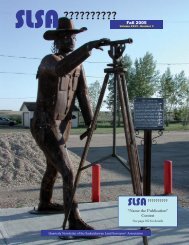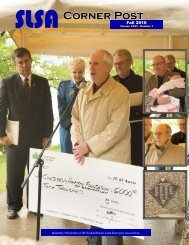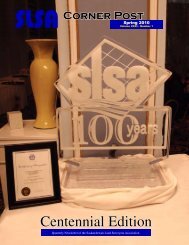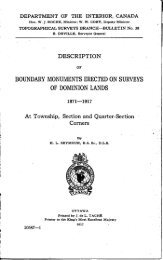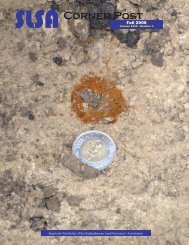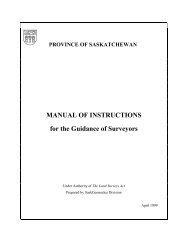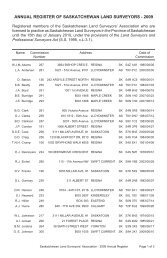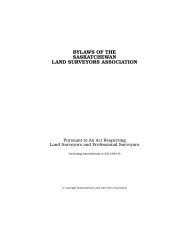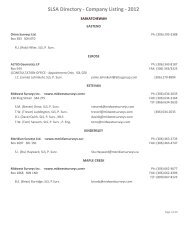Fall - Saskatchewan Land Surveyors Association
Fall - Saskatchewan Land Surveyors Association
Fall - Saskatchewan Land Surveyors Association
- No tags were found...
You also want an ePaper? Increase the reach of your titles
YUMPU automatically turns print PDFs into web optimized ePapers that Google loves.
paper. In early 2001, Mr. Allred submitted his paper to theALSA Council. He concluded that the current Section 9 ofthe Surveys Act is likely the only process for the resolution ofboundary type problems outside the court system. He wenton to say that it is clear that the breadth of this remedy wasseverely limited in the discussions that led up to the passingof the new Surveys Act. “It is also clear that ‘survey errors’are only a minor cause of boundary uncertainties and theprovisions of Section 9 of the Surveys Act do not extend farenough to resolve the majority of boundary problems. “In the 2001-2002 <strong>Association</strong> year, Council established aStatutory Boundary Tribunal committee. The Committeewas asked to analyze Mr. Allred’s report, conduct additionalresearch (research court cases, discipline files, speak with<strong>Land</strong> Titles and the Director of Surveys), and identify optionsfor change including revisions to the <strong>Land</strong> Titles Actand the Surveys Act.In December 2001, Mike Michaud, the Director of Surveys,and Tim Grusie, from <strong>Land</strong> Titles, had a meeting with Council.The Director of Surveys had written a letter to Councilon October 19, 2001 that the “need to develop a process fordealing with boundary problems is paramount.” Councilpassed a motion requesting that the Executive Committeedevelop a process for dealing with boundary problems.The Statutory Boundary Tribunal Committee struggled; ithad a difficult time focusing on what exactly the issues wereand how significant the issues were. In the end, the StatutoryBoundary Tribunal Committee passed a motion that theCommittee recommend to Council that Section 9 in principle,is suitable for dealing with boundary uncertaintiesas a result of survey errors. The Executive Committee alsostruggled with the issue. With all of its regular discussionsin advance of a Council meeting, it was impossible to focuson identifying the scope of the issue and then developing aprocess.In September 2002, Council disbanded the Statutory BoundaryTribunal and removed the action item from the ExecutiveCommittee’s terms of reference. Council established theSection 9 of the Surveys Act Ad Hoc Committee (Councilmotion 2002.09.010) with the following specific terms of reference:1. To review Section 9 to determine the legislated scope ofits powers and articulate what types of boundary uncertaintiesSection 9 is designed to resolve.2. Define the term “error in a survey.”3. To review the “Intent and Application of Section 9 of theSurveys Act” document, as published in the January 1991issue of ALS News to determine if it covers the entirescope of resolution of boundary uncertainties authorizedby Section 9.4. If it is determined that the “Intent and Application” documentdoes not cover the entire scope of resolution ofboundary uncertainties contemplated by Section 9, thendraft a new “Intent and Application” document.5. To investigate and review the current working applicationof Section 9 to determine if it is consistent with the“Intent and Application” document.6. If Section 9 is not sufficiently broad enough to deal withthe resolution of boundary uncertainties, to draft amendmentsto Section 9.7. Make recommendations back to Council.At the 2004 AGM, the concept of the Boundary ResolutionProcess was put to the membership in a straw vote. Therewas overwhelming support for the concept.How is the recommendation in the public interest?At its October 1 st and 2nd, 2003 strategic planning session,Council identified “resolving boundary uncertainties” as itstop priority and consistent with the mandate to protect thepublic interest.This recommendation by the Ad Hoc Committee establishesa process to help Alberta <strong>Land</strong> <strong>Surveyors</strong> resolve boundaryuncertainties. These uncertainties have an adverse effect onland owners now and in the future, and can present significantimpediments to the use and enjoyment of land. Moreover,failure to resolve boundary uncertainties may lead to acompounding of the seriousness and expense of resolution inthe future. A practical process for resolution of uncertaintieswill be of direct benefit to land owners and the public.The proposed process in this recommendation should meanthat boundary uncertainties will be resolved quicker.It means that the more serious boundary uncertainty or allegederror in survey cases will have been reviewed by agroup of the Alberta <strong>Land</strong> <strong>Surveyors</strong>’ peers who may be ableto recommend a method of resolving the matter.What is the Resolution Process?The Boundary Resolution Process has been developed to assistAlberta <strong>Land</strong> <strong>Surveyors</strong> to address boundary uncertaintiesand alleged errors in surveys that have been identifiedthrough their daily activities. There are two components tothe Boundary Resolution Process. First, if the involved Alberta<strong>Land</strong> <strong>Surveyors</strong> cannot informally resolve the situationthemselves, the Alberta <strong>Land</strong> <strong>Surveyors</strong>’ <strong>Association</strong>may assist with mediation. Second, if mediation has failed ordoes not apply, there is a referral from the Executive Directorto the Boundary Panel who would convene to determineif the boundary uncertainty is best resolved by Section 9 ofthe Surveys Act or some other means.272 SLSA Corner Post <strong>Fall</strong> 2006



